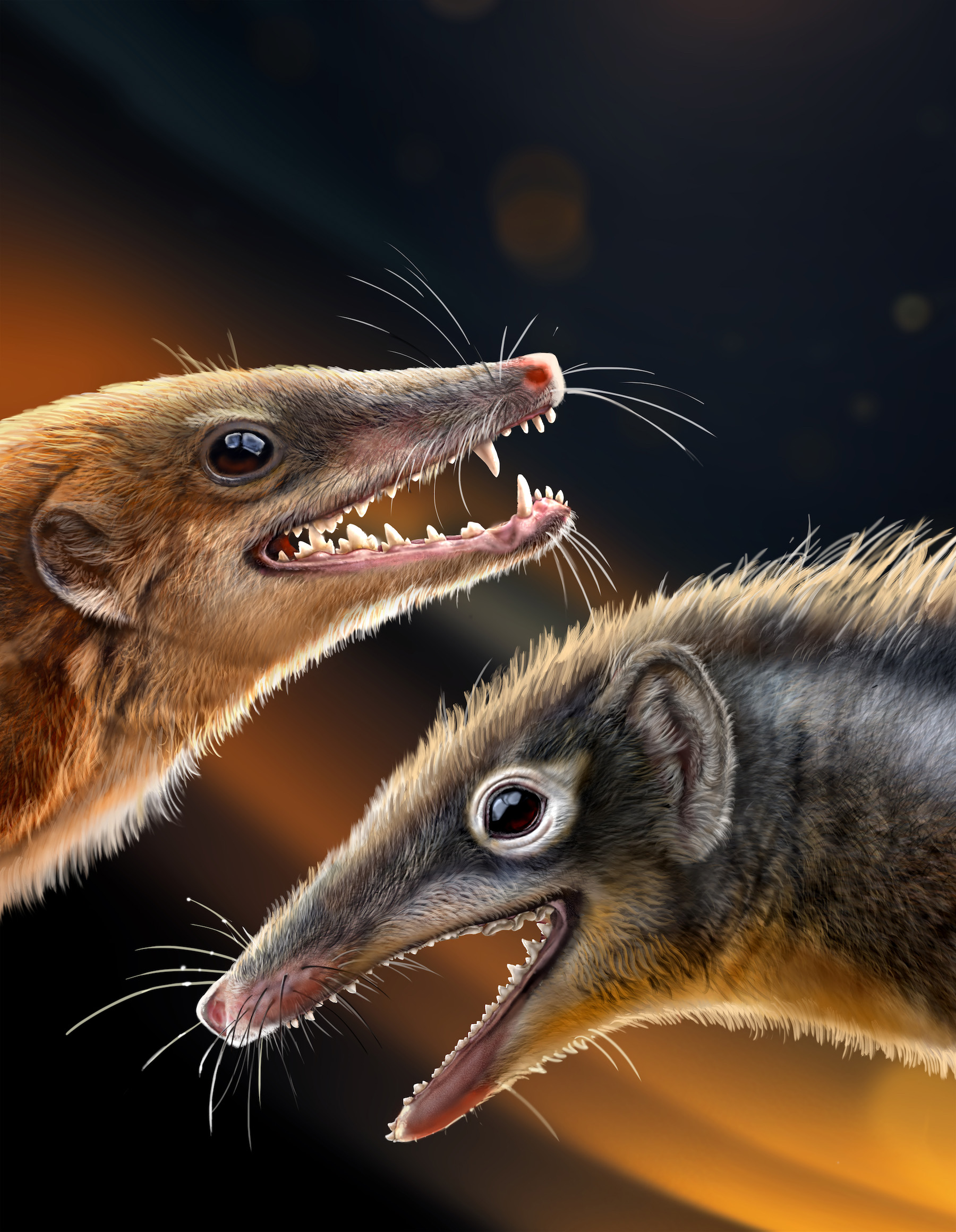Skip to comments.
Evolutionary Puzzle Solved? New Species Challenge Mammal Ancestry Theories
SciTechDaily ^
| April 30, 2024
| Chinese Academy of Sciences
Posted on 05/29/2025 10:15:28 PM PDT by SunkenCiv
Mammaliaforms encompass both living and extinct species that share a close relationship with mammals. Research on mammaliaforms aids scientists in deciphering the evolutionary developments responsible for various mammalian features.
In two consecutive studies in Nature, Dr. Mao Fangyuan and Dr. Zhang Chi from the Institute of Vertebrate Paleontology and Paleoanthropology (IVPP) of the Chinese Academy of Sciences, together with colleagues from Australia and the United States, recently reported two Jurassic mammaliaforms from China, revealing the earliest dental diversification, mandibular middle ears, and articular-quadrate joint transformation of mammaliaforms.
The studies provide key information about the evolutionary shift from reptilian jaw bones to early mammalian middle ear ossicles, presenting new perspectives on the early diversity of mammaliaforms and reshaping the early mammalian phylogeny.
(Excerpt) Read more at scitechdaily.com ...
TOPICS: History; Science; Travel
KEYWORDS: 50centarmy; birds; cretaceous; fauxiantroll; fauxiantrolls; fiftycentarmy; godsgravesglyphs; jurassic; mammals; paleontology; putinistas; redchina; youngearthdelusion; youngearthdelusions; zot
New research on Jurassic mammaliaforms from China reveals crucial evolutionary developments in dental structures and mandibular middle ears, shedding light on the transition from reptilian to mammalian features and enhancing our understanding of mammalian evolution. Reconstruction of Feredocodon chowi (right) and Dianoconodon youngi (left).Credit: IVPP

1
posted on
05/29/2025 10:15:28 PM PDT
by
SunkenCiv
Scientists discovered two Jurassic bird fossils in China, pushing back bird diversification by 20 million years. One, Baminornis zhenghensis, had a short tail and mixed dinosaur-like and bird-like traits. The second, an isolated furcula, may belong to Ornithuromorpha but requires further study.
A research team led by Professor Min Wang from the Institute of Vertebrate Paleontology and Paleoanthropology (IVPP) at the Chinese Academy of Sciences has discovered two bird fossils in Jurassic-era rocks in Fujian Province, southeast China.
Dating back approximately 149 million years, these fossils help bridge a spatiotemporal gap in the early evolution of birds. They also provide the strongest evidence to date that birds had already diversified by the end of the Jurassic period.
Birds are the most diverse group of terrestrial vertebrates. Certain macroevolutionary studies suggest that their earliest diversification dates back to the Jurassic period (approximately 145 million years ago). However, the earliest evolutionary history of birds has long been obscured by a highly fragmentary fossil record, with Archaeopteryx being the only widely accepted Jurassic bird.Scientists Have Uncovered One of the Oldest Birds Ever – And It's Unlike Anything We've Seen | Chinese Academy of Sciences | March 4, 2025
The evolutionary tree showing the position of Baminornis zhenghensis, and the morphometric space illustrating the modular evolution of different body parts.Credit: Min Wang

2
posted on
05/29/2025 10:17:44 PM PDT
by
SunkenCiv
(The moron troll Ted Holden believes that humans originated on Ganymede.)
A fossilized Jeholornis provides the first evidence of leaf-eating birds, revealing their early ties to flowering plants over 100 million years ago.
New findings from the analysis of a 120-million-year-old fossil skeleton of the extinct bird Jeholornis, unearthed from northeastern China, present the earliest known evidence of leaf-eating birds, marking the earliest known evolution of arboreal plant-eating among birds.
The pheasant-sized Jeholornis, a member of the second most primitive lineage of known birds, has teeth and a long bony tail like its predatory, feathered dinosaur relatives. However, microscopic analysis of the fossilized residues in the stomach of this juvenile, arboreal (tree-living) bird demonstrates that Jeholornis was not a predator. It had eaten tree leaves from a group of flowering plants called magnoliids that includes the living magnolia, cinnamon, and avocado trees...
The presence of gizzard stones (gastroliths) used to grind plant parts during digestion in the stomach areas of fossil skeletons allow paleontologists to determine that the diets of some early birds included plant parts. More direct evidence of plants in the diet of the earliest lineages of birds comes from other fossil skeletons of Jeholornis with fossilized fruit and seeds preserved in their digestive system.
The 120-million-year-old fossil skeleton with feathers of the juvenile early bird Jeholornis from China, showing some microscopic fossil phytolith remains of its last meal of leaves from magnoliid trees that were extracted from the remains of the bird’s stomach, in comparison with phytoliths from living magnoliid trees.Credit: IVPP

3
posted on
05/29/2025 10:19:46 PM PDT
by
SunkenCiv
(The moron troll Ted Holden believes that humans originated on Ganymede.)
To: SunkenCiv
Thinking themselves wise, they became fools...
Comment #5 Removed by Moderator
To: StayAt HomeMother; Ernest_at_the_Beach; 1ofmanyfree; 21twelve; 24Karet; 2ndDivisionVet; 31R1O; ...
6
posted on
05/29/2025 10:24:54 PM PDT
by
SunkenCiv
(The moron troll Ted Holden believes that humans originated on Ganymede.)
To: SunkenCiv
We did finally find the missing link in evolution

7
posted on
05/29/2025 10:25:05 PM PDT
by
NoLibZone
(Trump failure: Not declaring Antifa a terrorist organization.)
To: Democrat = party of treason
8
posted on
05/29/2025 11:03:11 PM PDT
by
SaveFerris
(Luke 17:28 ... as it was in the Days of Lot; They did Eat, They Drank, They Bought, They Sold ......)
To: Democrat = party of treason
I’m puzzled by the chinese scientists giving the newly-discovered specimens latin names, and not chinese names.
9
posted on
05/30/2025 12:10:24 AM PDT
by
Tucker39
("It is impossible so to rightly govern a nation without God and the Bible." George Washington )
To: Tucker39
Carl Linnaeus (18th century) started the current naming convention. The Chinese are just conforming to that convention, since they are coming late to the game. If they used another convention, they could not easily communicate with their peers.
10
posted on
05/30/2025 3:38:38 AM PDT
by
maro
(MAGA!)
To: Democrat = party of treason
11
posted on
05/30/2025 5:00:31 AM PDT
by
Bloody Sam Roberts
(Perfection is impossible. But if you pursue perfection...you may achieve excellence.)
To: SunkenCiv
That is so clear I’m shocked no one saw it before. /s
It could also be the jaw of a cat with lizard pieces in it, all piled up in mud that turned to stone. Thank you very much. Where do I go to get my million dollar grant to study it further?
EC
To: SunkenCiv
I am reminded of what we were taught in High School 65 years ago.
THEORY: “Something that sounds scientific but can not be proven.”
To: SunkenCiv
Those things look like possums.
To: SunkenCiv
To: SunkenCiv
"The fossil record is like a film of evolution from which 999 out of 1,000 frames have been lost." -- David Quammen, “Was Darwin Wrong?” National Geographic, November 2004, 25.
Four billion years of alleged evolution and then, in the Cambrian, the first of every major phylum appear fully formed. Cultural Christian, Richard Dawkins:
“And we find many of them already in an advanced state of evolution, the very first time they appear. It is as though they were just planted there, without any evolutionary history. Needless to say, this appearance of sudden planting has delighted creationists….the only alternative explanation of the sudden appearance of so many complex animal types in the Cambrian era is divine creation…”
"The absence of fossil evidence for intermediary stages between major transitions in organic design, indeed our inability, even in our imagination, to construct functional intermediates in many cases, has been a persistent and nagging problem for gradualistic accounts of evolution." Stephen Jay Gould (Professor of Geology and Paleontology, Harvard University)
In short, the theory of manmade climate change looks credible compared the failed theory of evolution, which is nothing but a religion of atheists/secular humanists/leftists.
16
posted on
05/30/2025 9:16:03 AM PDT
by
Kazan
To: FroggyTheGremlim
The first one has real carnivore teeth and looks like a pet that could help you keep nuisance animals out of the house. The second one has those little bug crunching teeth and human ears, cant respect it and too weird to cuddle with.
17
posted on
05/31/2025 5:25:50 PM PDT
by
gnarledmaw
(If you dont like my sense of humor, please let me know so I can laugh at you too.)
Disclaimer:
Opinions posted on Free Republic are those of the individual
posters and do not necessarily represent the opinion of Free Republic or its
management. All materials posted herein are protected by copyright law and the
exemption for fair use of copyrighted works.
FreeRepublic.com is powered by software copyright 2000-2008 John Robinson




